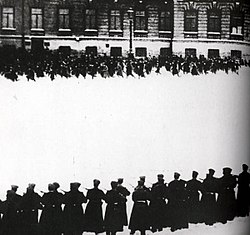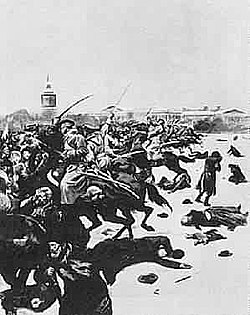Bloody Sunday (1905): Difference between revisions
No edit summary |
|||
| Line 5: | Line 5: | ||
==Preludes== |
==Preludes== |
||
[[Image:BloodySunday1905.jpg|thumb|250px||right|The Tsar's soldiers shooting at peaceful demonstrators at the [[Winter Palace]] in modern [[St. Petersburg]]. Still from a Soviet propaganda movie. 1925]]That December, a strike occurred at the [[Putilov plant]]. Sympathy strikes in other parts of the city raised the number of strikers above 80,000. By [[January 8]], the city had no electricity and no newspapers. All public areas were declared closed. Father Gapon organized a peaceful 'workers' procession' to the [[Winter Palace]] to deliver a petition to the Tsar that Sunday stating reforms they had desperately wanted. Reforms such as an end to the [[Russo-Japanese war]] and more suffrage as well as shortening the workers day to 8 hours, fair pay and condemnation of the overtime that the factory owners had forced upon their workers. The procession was well stewarded by followers of Gapon and any terrorists and hot-heads were removed and all the participants checked for weapons. He was warned not to act. Troops had been deployed around the Winter Palace and at other key points. The Tsar left the city on [[January 8]] for [[Tsarskoe Selo]]. |
[[Image:BloodySunday1905.jpg|thumb|250px||right|The Tsar's soldiers shooting at peaceful demonstrators at the [[Winter Palace]] in modern [[St. Petersburg]]. Still from a Soviet propaganda movie. 1925]]That December, a strike occurred at the [[Putilov plant]]. Sympathy strikes in other parts of the city raised the number of strikers above 80,000. By [[January 8]], the city had no electricity and no newspapers. All public areas were declared closed. Father Gapon organized a peaceful 'workers' procession' to the [[Winter Palace]] to deliver a petition to the Tsar that Sunday stating reforms they had desperately wanted. Reforms such as an end to the [[Russo-Japanese war]] and more suffrage as well as the shortening of the workers day to 8 hours, fair pay and condemnation of the overtime that the factory owners had forced upon their workers. The procession was well stewarded by followers of Gapon and any terrorists and hot-heads were removed and all the participants checked for weapons. He was warned not to act. Troops had been deployed around the Winter Palace and at other key points. The Tsar left the city on [[January 8]] for [[Tsarskoe Selo]]. |
||
==Bloody Sunday== |
==Bloody Sunday== |
||
Revision as of 10:29, 7 September 2007
- For other incidents referred to by this name, see Bloody Sunday.

Bloody Sunday (Russian: Кровавое воскресенье) was an incident on 22 January [O.S. 9 January] 1905 in St. Petersburg, Russia, where unarmed, peaceful demonstrators marching to present a petition to Tsar Nicholas II were gunned down by the Imperial Guard. The event was organized by Father Gapon, who was paid by the Okhrana, the Czarist secret police, and thus considered to be its agent provocateur. Bloody Sunday was a serious blunder on the part of the Okhrana, and an event with grave consequences for the Tsarist regime, as the blatant disregard for ordinary people shown by the massacre undermined support for the state. Despite the consequences of this action, the Tsar was never fully blamed because he was not in the city at the time of protest[citation needed].
Preludes

That December, a strike occurred at the Putilov plant. Sympathy strikes in other parts of the city raised the number of strikers above 80,000. By January 8, the city had no electricity and no newspapers. All public areas were declared closed. Father Gapon organized a peaceful 'workers' procession' to the Winter Palace to deliver a petition to the Tsar that Sunday stating reforms they had desperately wanted. Reforms such as an end to the Russo-Japanese war and more suffrage as well as the shortening of the workers day to 8 hours, fair pay and condemnation of the overtime that the factory owners had forced upon their workers. The procession was well stewarded by followers of Gapon and any terrorists and hot-heads were removed and all the participants checked for weapons. He was warned not to act. Troops had been deployed around the Winter Palace and at other key points. The Tsar left the city on January 8 for Tsarskoe Selo.
Bloody Sunday
On the fated Sunday, striking workers and their families gathered at six points in the city. Clutching religious icons and singing hymns and patriotic songs (particularly "God save the Tsar), they proceeded towards the Winter Palace without police interference. The demonstrators brought along their families in hope of seeing their beloved Tsar and delivering the petition to him as they believed he would take into account their miseries and attempt to sort their problems for them, they believed it would be a peaceful and patriotic day during which they could pass on their polite pettition to the Tsar. However, the army pickets near the palace fired warning shots, and then fired directly into the crowds to disperse them. Gapon was fired upon near the Narva Gate. Around forty people surrounding him were killed, but he was uninjured[citation needed].

The number killed is uncertain. The Tsar's officials recorded 96 dead and 333 injured; anti-government sources claimed more than 4,000 dead; moderate estimates still average around 1,000 killed or wounded, both from shots and trampled during the panic. Nicholas II described the day as 'painful.' As reports spread across the city, disorder and looting broke out. Gapon's Assembly was closed down that day, and Gapon quickly left Russia. Returning in October, he was assassinated by his friend Pinhas Rutenberg when Gapon revealed that he was working for the Secret Police[citation needed].
This event inflamed revolutionary activities in Russia that resulted in the Revolution of 1905.
In Music
Russian composer Dmitri Shostakovich wrote his Eleventh Symphony as a program composition about Bloody Sunday and the revolution, with the third movement paying homage to the fallen workers gunned down by the Tsarist army.
